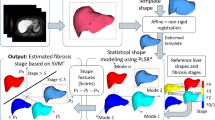Abstract
Liver-shape analysis and quantification is still an open research subject. Quantitative assessment of the liver is of clinical importance in various procedures such as diagnosis, treatment planning, and monitoring. Liver-shape classification is of clinical importance for corresponding intra-subject and inter-subject studies. In this research, we propose a novel technique for the liver-shape classification based on Spherical Harmonics (SH) coefficients. The proposed liver-shape classification algorithm consists of the following steps: (a) Preprocessing, including mesh generation and simplification, point-set matching, and surface to template alignment; (b) Liver-shape parameterization, including surface normalization, SH expansion followed by parameter space registration; (c) Feature selection and classification, including frequency based feature selection, feature space reduction by Principal Component Analysis (PCA), and classification. The above multi-step approach is novel in the sense that registration and feature selection for liver-shape classification is proposed and implemented and validated for the normal and diseases liver in the SH domain. Various groups of SH features after applying conventional PCA and/or ordered by p-value PCA are employed in two classifiers including Support Vector Machine (SVM) and k-Nearest Neighbor (k-NN) in the presence of 101 liver data sets. Results show that the proposed specific features combined with classifiers outperform existing liver-shape classification techniques that employ liver surface information in the spatial domain. In the available data sets, the proposed method can successful classify normal and diseased livers with a correct classification rate of above 90 %. The performed result in average is higher than conventional liver-shape classification method. Several standard metrics such as Leave-one-out cross-validation and Receiver Operating Characteristic (ROC) analysis are employed in the experiments and confirm the effectiveness of the proposed liver-shape classification with respect to conventional techniques.









Similar content being viewed by others
Notes
((49 diseased +52 normal)−1)
References
Gao, L.M., Heath, D.G., Kuszyk, B.S., Fishman, E.K., Automatic liver segmentation technique for three-dimensional visualisation of ct data. Radiology 201(2):359–364, 1996.
Okada, T., Shimada, Hori, R.M., Nakamoto, M., Chen, Y.W., Nakamura, H., Sato, Y., Automated segmentation of the liver from 3d ct images using probabilistic atlas and multilevel statistical shape model. Academic Radiology 15(11):1390–1403, 2008.
Weisstein, E.W.: Spherical Harmonic. From MathWorld: A Wolfram Web Resource. http://mathworld.wolfram.com
Goldberg-Zimring, D., Talos, I. F., Bhagwat, J. G., Haker, S. J., Black, P. M., Zou, K. H., Statistical validation of brain tumor shape approximation via spherical harmonics for image-guided neurosurgery. Academic Radiology 12(4):459–466, 2005.
Dillenseger, J. L., Guillaume, H., Patard, J. J., Spherical harmonics based intrasubject 3-d kidney modeling/registration technique applied on partial information. IEEE Transactions on Biomedical Engineering 53(11):2185–2193, 2006.
Heng, H. A., Shen, L., Zhang, R., Makedon, F., Saykin, A., Pearlman, J., A novel surface registration algorithm with biomedical modeling applications. IEEE Transactions on Information Technology in Biomedicine 11(4):474–482, 2007.
Shen, L., Farid, H., McPeek, M. A., Modeling three-dimensional morphological structures using spherical harmonics. Evolution 63(4):1003–1016, 2009.
Mofrad, F. B., Tehrani-Fard, A. A., Zoroofi, R. A., Akhlaghpoor, S., Chen, Y. W., A novel wavelet based multi-scale statistical shape model-analysis for the liver application: segmentation and classification. Current Medical Imaging Reviews 6(3):145–155, 2010.
Mofrad, F. B., Zoroofi, R. A., Tehrani-Fard, A. A., Akhlaghpoor, Sh., Hori, M., Chen, Y. W., Sato, Y., Statistical construction of a japanese male liver phantom for internal radionuclide dosimetry. Radiat. Prot. Dosimetry 141(2):140–148, 2010.
Goldberg-Zimring, D., Shalmon, B., Zou, K. H., Azhari, H., Nass, D., Achiron, A., Assessment of multiple sclerosis lesions with spherical harmonics: comparison of mr imaging and pathologic findings. Radiology 235(3):1036–1044, 2005.
Li, J., and Hero, A. O., A fast spectral method for active 3d shape reconstruction. Journal of Mathematical Imaging and Vision 20(1–2):73–87, 2004.
Shen, L., Ford, J., Makedon, F., Saykin, A., A surface-based approach for classification of 3D neuroanatomical structures, Intelligent Data Analysis 8(6):519–542, 2004.
Styner, M., Gerig, G., Lieberman, J., Jones, D., Weinberger, D., Statistical shape analysis of neuroanatomical structures based on medial models. Medical Image Analysis 7(3):207–220, 2003.
Myronenko, A., Song, X. B., Carreira-Perpinan, M.A., Non-rigid point set registration: Coherent Point Drift. Neural Information Processing Systems Proceedings,1009–1016, 2006.
Chui, H. L., and Rangarajan, A., A new point matching algorithm for non-rigid registration. Computer Vision and Image Understanding 89(2–3):114–141, 2003.
Besl, P. J., and Mckey, N. D., A method for Registration of 3-D Shape. IEEE Transactions on Pattern analysis and Machine Vision 14(2):239–256, 1992.
Delaunay, B., Sur la sphere vide, Izvestia Akademii Nauk. SSSR. Otdelenie Matematicheskikh i Estestvennykh Nauk 7:793–800, 1934.
Brechbuhler, C., Gerig, G., Kubler, O., Parametrization of closed surfaces for 3-d shape-description. Computer Vision and Image Understanding 61(2):154–170, 1995.
Burel, G., and Henocq, H., Determination of the orientation of 3d objects using spherical harmonics. Graphical Models and Image Processing 57(5):400–408, 1995.
Mitchell, T., Machine Learning: McGraw-Hill, 1997.
Dasarathy, B. V., Nearest Neighbor (NN) Norms: NN Pattern Classification Techniques. Los Alamitos, CA: IEEE Computer Society Press, 1991.
Vapnik, V., The Nature of Statistical Learning Theory. New York: Springer, 1995.
Vapnik, V., Statistical Learning Theory: John Wiley and Sons, 1998.
Armitage, P., and Berry, G., Statistical Methods in Medical Research (3rd edition). Blackwell, 1994.
Bradley, A. P, The use of the area under the roc curve in the evaluation of machine learning algorithms. Pattern Recognition 30(7):1145–1159, 1997.
Swets, J. A., Measuring the accuracy of diagnostic systems. Science 240(4857):1285–1293, 1988.
Author information
Authors and Affiliations
Corresponding author
Additional information
This article is part of the Topical Collection on Transactional Processing Systems
Rights and permissions
About this article
Cite this article
Mofrad, F.B., Zoroofi, R.A., Tehrani-Fard, A.A. et al. Classification of Normal and Diseased Liver Shapes based on Spherical Harmonics Coefficients. J Med Syst 38, 20 (2014). https://doi.org/10.1007/s10916-014-0020-6
Received:
Accepted:
Published:
DOI: https://doi.org/10.1007/s10916-014-0020-6




